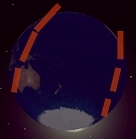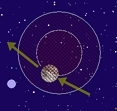- - text and links as of last publication - -
![]()
-------------------
note: due to the source we are using to compute the data of the lunar eclipses, the data therein may be unaccurate. For more accurate data, you may turn to dedicated sites like Fred Espenak's NASA Eclipse Web Site
-------------------
The first lunar eclipse in 2010 is a partial lunar eclipse. It's occurring on June 26th, 2010. It's a fine, classical partial eclipse, like the diagram is showing, with the Moon to be seen neatly indented by the shadow of the Earth! A partial eclipse occurs when the Moon is passing partially only into the Earth's dark 'umbra'. That leads to that some part of the Moon is neatly indented. A fine show! for more about Moon eclipses, theoretically, see our tutorial: Moon Eclipses
Due to the geometry of the eclipse, it is the northern regions of the Moon which will be affected by the Earth's umbra, as the eclipse is unfolding against the constellation Sagittarius, the Archer. The whole of the eclipse is observable over the few inhabited reaches of the Pacific Ocean. Most of the Pacific island-nations or territories however will have the show available as will most of Australia, New Zealand, and the northwestern parts of North America. Like usually the case for a lunar eclipse, the areas West of there, will have the eclipse en cours by moonrise as areas East will have the eclipse interrupted by moonset. The former comprize the area up to eastern India, and the latter up to North America and the West of South America. Regions of the world located between India and western Mongolia and the East of South America don't have any eclipse. The eclipse is beginning by 09:01 UT. It's reaching its greatest by 11:38 UT as it will span over a 4h 5 mn timespan
 |  |  | Those views are showing, from left to right, the regions of the Earth, where the June 26th, 2010 partial lunar eclipse is wholly visible, the path of the eclipse through the Earth's penumbra and umbra, and the how the eclipse will look like at its greatest. pictures site 'Amateur Astronomy', based on Celestia (pictures at the far left and the far right) and Cartes du Ciel (picture center) |
The eclipse's main data are the following (data Fred Espenak, NASA/GSFC, undisclosed date). for more about how to observe a lunar eclipse, see our tutorial "Observing a Moon Eclipse":
- umbral magnitude (fraction of Moon's diameter immersed in the umbra at greatest): 0.542
- penumbral magnitude (fraction of Moon's diameter immersed in the penumbra at greatest): 1.603
- greatest eclipse: 11:38 UT
- eclipse semi-duration (penumbral): 01:22
- eclipse semi-duration (umbral): na
. for more about this eclipse and for more about solar and lunar eclipses generally, you may see, for example, Fred Espenak's NASA Eclipse Web Site
Observation Reports: - no observation report available -
Website Manager: G. Guichard, site 'Amateur Astronomy,' http://stars5.6te.net. Page Editor: G. Guichard. last edited: 12/28/2010. contact us at ggwebsites@outlook.com